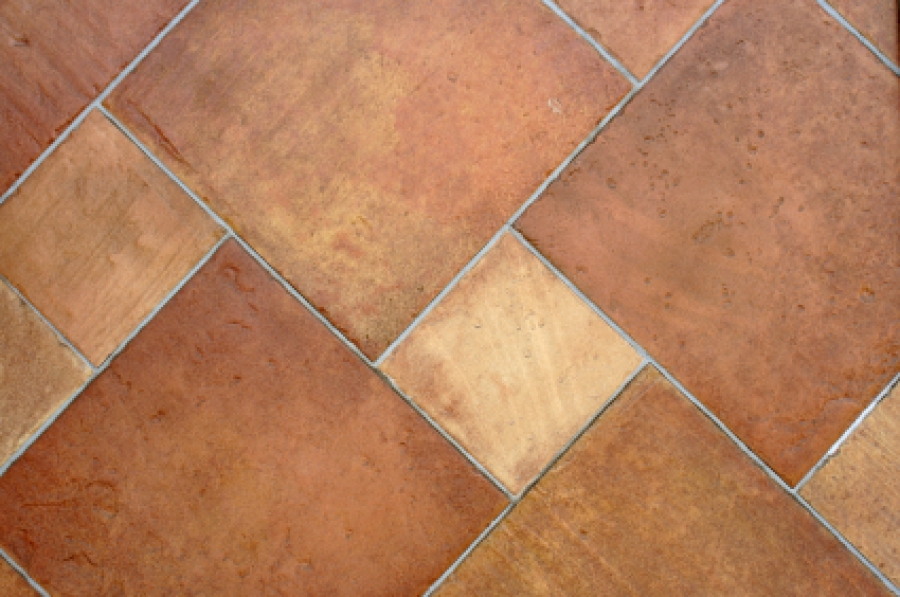Tile Flooring 101: Care and Maintenance
Tile floors are an extremely durable, long-term investment that should be regularly cared for to preserve both their appearance and value. In fact, a well cared for tile floor can last a lifetime. According to the Study of Life Expectancy of Home Components, which was prepared in 2007 by the National Association of Home Builders (NAHB), the average life expectancy of a ceramic tile floor is 75 to 100 years, while natural stone such as marble and granite can last more than 100 years.

Tile floors are actually rather easy to care for and are nearly maintenance free. The best way to care for a tile floor is to be both proactive and reactive. Proactively keep debris such as sand and/or dirt off of the floor. Debris can be abrasive to a tile floor surface. Regularly vacuuming and/or sweeping with a dust mop will prevent surface scratching. Deeper cleaning of a tile floor can be accomplished using a damp mop and a cleaning solution. Acidic, ammonia-based, bleach and abrasive cleaners should not be used. It is best to consult with the tile manufacturer to determine the most appropriate cleaning solution for your tile floor. On a daily basis, it is advisable to react to spills immediately by wiping them up and then cleaning the spill area using a sponge, with a soap and water mixture. This will protect the tiles appearance and prevent any potential staining from occurring.
Place walk-off mats at entryways and area rugs in high traffic or water susceptible areas. Mats and rugs will collect dirt and debris that would otherwise reach the floor. On a regular basis, the mats and rugs should be shaken out to remove debris. Depending on what type of furniture you have, you may want to install feet protectors. These will alleviate any potential scratching or staining that could occur. Be extremely careful when moving furniture, ensuring the piece is lifted up and then carried to its location. Dragging furniture across a tile floor will result in surface scratches or cause more significant damage to tile.
Grout Sealing
Whether or not you seal your tile floor and how often you seal it depends upon the type of tile, its level of porosity and its location. The grout located between floor tiles should be sealed on a regular basis. Prior to sealing grout, the tile floor should be cleaned and dried. Sealed grout and/or tile repels moisture, protecting the floor from staining or discoloration. It is best to consult with a tile and/or grout manufacturer to determine the most appropriate type of sealant for your tile floor.
Repairs
Tile floors do not need to be refinished, resurfaced or reglazed during their lifetime. However, they may need to be repaired. Overtime damage can occur to a grouted joint or a tile may break. In either case the grouted joint should first be removed using a mechanical rotary tool or a hand tool, such as a chisel. Work carefully to prevent damaging adjacent tiles. If the grouted joint is the extent of the damage, the joint should be free and clear of debris, then re-grouted. If the tile is damaged you will need to remove all grouted joints that surround the tile, then carefully chisel or mechanically cut the tile into small pieces and remove. The mortar or adhesive on the floor under the tile should be scraped and removed as well. Once the area is free and clear of any debris, apply mortar to the back of the replacement tile; place in the existing location and squarely position the tile onto the backer board. The top of tile should be flush with the adjacent floor tiles.

Jeff Calcamuggio
Jeff is an Editor-at-Large for Buildipedia.com who writes and edits Featured At Home and Knowledgebase content. Prior to joining Buildipedia, Jeff's work experience included carpentry, construction documentation, specification writing, construction administration, project management, and real estate property inspection. Jeff is a member of the Construction Specifications Institute (CSI) and an educator at Columbus State Community College and enjoys challenging DIY home improvement projects.
†


